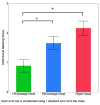Naturalistic Language Recordings Reveal "Hypervocal" Infants at High Familial Risk for Autism
- PMID: 28295208
- PMCID: PMC5592123
- DOI: 10.1111/cdev.12777
Naturalistic Language Recordings Reveal "Hypervocal" Infants at High Familial Risk for Autism
Abstract
Children's early language environments are related to later development. Little is known about this association in siblings of children with autism spectrum disorder (ASD), who often experience language delays or have ASD. Fifty-nine 9-month-old infants at high or low familial risk for ASD contributed full-day in-home language recordings. High-risk infants produced more vocalizations than low-risk peers; conversational turns and adult words did not differ by group. Vocalization differences were driven by a subgroup of "hypervocal" infants. Despite more vocalizations overall, these infants engaged in less social babbling during a standardized clinic assessment, and they experienced fewer conversational turns relative to their rate of vocalizations. Two ways in which these individual and environmental differences may relate to subsequent development are discussed.
© 2017 The Authors. Child Development © 2017 Society for Research in Child Development, Inc.
Figures


Similar articles
-
Early language exposure supports later language skills in infants with and without autism.Autism Res. 2019 Dec;12(12):1784-1795. doi: 10.1002/aur.2163. Epub 2019 Jun 28. Autism Res. 2019. PMID: 31254329 Free PMC article.
-
Maternal Vocal Feedback to 9-Month-Old Infant Siblings of Children with ASD.Autism Res. 2016 Apr;9(4):460-70. doi: 10.1002/aur.1521. Epub 2015 Jul 14. Autism Res. 2016. PMID: 26174704 Free PMC article.
-
Evaluating canonical babbling ratios extracted from day-long audio recordings in infants later diagnosed with autism spectrum disorder.Infant Behav Dev. 2025 Jun;79:102059. doi: 10.1016/j.infbeh.2025.102059. Epub 2025 Apr 25. Infant Behav Dev. 2025. PMID: 40286507
-
Early motor delays as diagnostic clues in autism spectrum disorder.Eur J Pediatr. 2017 Sep;176(9):1259-1262. doi: 10.1007/s00431-017-2951-7. Epub 2017 Jun 28. Eur J Pediatr. 2017. PMID: 28660313 Review.
-
The development of the social brain in baby siblings of children with autism.Curr Opin Psychiatry. 2020 Mar;33(2):110-116. doi: 10.1097/YCO.0000000000000572. Curr Opin Psychiatry. 2020. PMID: 31815759 Free PMC article. Review.
Cited by
-
The Vocabulary of Infants with an Elevated Likelihood and Diagnosis of Autism Spectrum Disorder: A Systematic Review and Meta-Analysis of Infant Language Studies Using the CDI and MSEL.Int J Environ Res Public Health. 2022 Jan 27;19(3):1469. doi: 10.3390/ijerph19031469. Int J Environ Res Public Health. 2022. PMID: 35162492 Free PMC article.
-
Vocalization frequency as a prognostic marker of language development following early cochlear implantation.Audiol Res. 2019 May 6;9(1):217. doi: 10.4081/audiores.2019.217. eCollection 2019 May 6. Audiol Res. 2019. PMID: 31183023 Free PMC article.
-
[Characteristics of vocalization in children with autism spectrum disorder during the still-face paradigm].Zhongguo Dang Dai Er Ke Za Zhi. 2020 Apr;22(4):361-367. doi: 10.7499/j.issn.1008-8830.2001006. Zhongguo Dang Dai Er Ke Za Zhi. 2020. PMID: 32312376 Free PMC article. Chinese.
-
Should Echolalia Be Considered a Phonic Stereotypy? A Narrative Review.Brain Sci. 2021 Jun 29;11(7):862. doi: 10.3390/brainsci11070862. Brain Sci. 2021. PMID: 34209516 Free PMC article. Review.
-
Early language exposure supports later language skills in infants with and without autism.Autism Res. 2019 Dec;12(12):1784-1795. doi: 10.1002/aur.2163. Epub 2019 Jun 28. Autism Res. 2019. PMID: 31254329 Free PMC article.
References
-
- Baptista LF, Petrinovich L. Song development in the white-crowned sparrow: social factors and sex differences. Animal Behaviour. 1986;34:1359–1371. doi: 10.1016/S0003-3472(86)80207-X. - DOI
-
- Brian AJ, Roncadin C, Duku E, Bryson SE, Smith IM, Roberts W, … Zwaigenbaum L. Emerging cognitive profiles in high-risk infants with and without autism spectrum disorder. Research in Autism Spectrum Disorders. 2014;8:1557–1566. doi: 10.1016/j.rasd.2014.07.021. - DOI
-
- Cameron NM, Champagne FA, Parent C, Fish EW, Ozaki-Kuroda K, Meaney MJ. The programming of individual differences in defensive responses and reproductive strategies in the rat through variations in maternal care. Neuroscience and Biobehavioral Reviews. 2005;29:843–65. doi: 10.1016/j.neubiorev.2005.03.022. - DOI - PubMed
-
- Campbell SB, Leezenbaum NB, Mahoney AS, Day TN, Schmidt EN. Social engagement with parents in 11-month-old siblings at high and low genetic risk for autism spectrum disorder. Autism: The International Journal of Research and Practice. 2015;19:915–24. doi: 10.1177/1362361314555146. - DOI - PMC - PubMed
Publication types
MeSH terms
Grants and funding
LinkOut - more resources
Full Text Sources
Other Literature Sources
Medical

